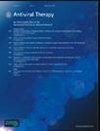黄花蒿水提物对HSV-1病毒UL46和US6基因的抗病毒作用
IF 1.3
4区 医学
Q4 INFECTIOUS DISEASES
引用次数: 2
摘要
1型单纯疱疹病毒与口腔病变有关。近年来,人们对不同植物的抗疱疹活性进行了研究。在本研究中,研究了aucheri Artemisia aucheri水提物对HSV-1病毒感染的Vero细胞的作用。在病毒感染前1 ~ 2 h,植物水提液浓度为75 μg/mL时细胞活力最高。计算24.7 μg/ml水提物的IC50。75 μg/ml的氯仿部位对感染细胞的抑制率最高(89.6%),12.5 μg/ml的乙酸乙酯部位对感染细胞的抑制率最低(21.7%)。此外,Q-PCR结果显示,在不同处理下,UL46和US6基因的表达显著降低。综上所述,本研究表明,药用植物aucheri Artemisia aucheri的水提物具有抗病毒特性,可作为治疗HSV-1的药物。本文章由计算机程序翻译,如有差异,请以英文原文为准。
Antiviral effect of Artemisia aucheri aqueous extract on UL46 and US6 genes of HSV-1
HSV-1 is associated with oral lesions. Recently, anti-herpetic activity of different plant species has been investigated. In this study, the effects of Artemisia aucheri aqueous extract on the HSV-1 virus-infected Vero cells were assessed. The highest cell viability occurred in plant aqueous extracts was with a concentration of 75 μg/mL, 1–2 h before viral infection. The IC50 of the aqueous extract of 24.7 μg/ml was calculated. Most percentage of infected cell inhibition (89.6%) was with the chloroform fraction in concentration of 75 μg/ml, and the least percentage of infected cell inhibition (21.7%) was in concentration of 12.5 μg/ml with the ethyl acetate fraction in comparison with untreated control. Moreover, Q-PCR results revealed that the expression of genes UL46 and US6 were significantly reduced in the presence of different treatments utilized in the experiment. In conclusion, the present study proposes that aqueous extracts of medicinal plant Artemisia aucheri have anti-viral property and may be considered as a remedy for HSV-1 treatment.
求助全文
通过发布文献求助,成功后即可免费获取论文全文。
去求助
来源期刊

Antiviral Therapy
医学-病毒学
CiteScore
2.60
自引率
8.30%
发文量
35
审稿时长
4-8 weeks
期刊介绍:
Antiviral Therapy (an official publication of the International Society of Antiviral Research) is an international, peer-reviewed journal devoted to publishing articles on the clinical development and use of antiviral agents and vaccines, and the treatment of all viral diseases. Antiviral Therapy is one of the leading journals in virology and infectious diseases.
The journal is comprehensive, and publishes articles concerning all clinical aspects of antiviral therapy. It features editorials, original research papers, specially commissioned review articles, letters and book reviews. The journal is aimed at physicians and specialists interested in clinical and basic research.
 求助内容:
求助内容: 应助结果提醒方式:
应助结果提醒方式:


